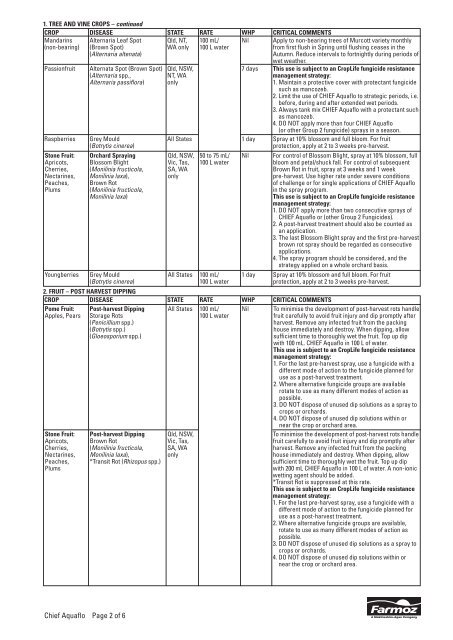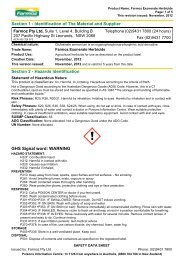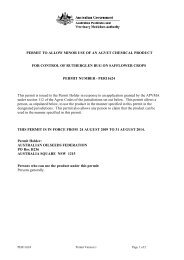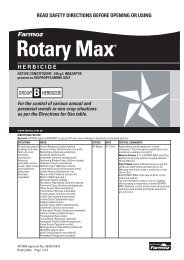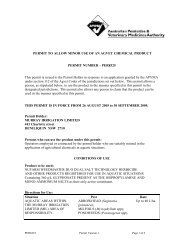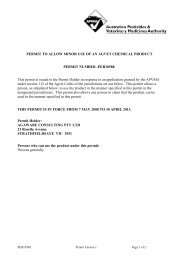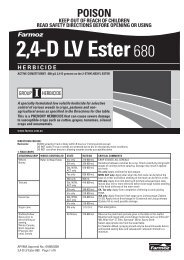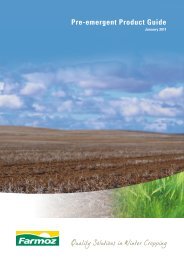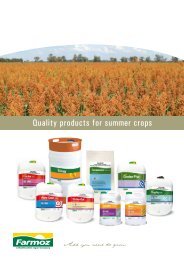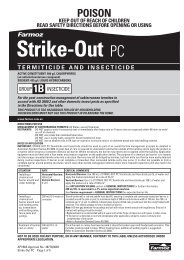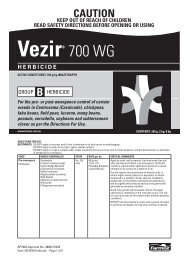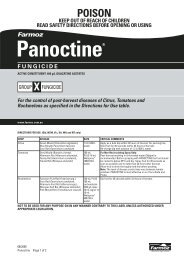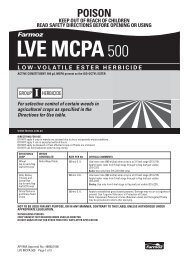View Label - Farmoz
View Label - Farmoz
View Label - Farmoz
You also want an ePaper? Increase the reach of your titles
YUMPU automatically turns print PDFs into web optimized ePapers that Google loves.
1. TREE AND VINE CROPS – continued<br />
CROP DISEASE STATE RATE WHP CRITICAL COMMENTS<br />
Mandarins Alternaria Leaf Spot Qld, NT, 100 mL/ Nil Apply to non-bearing trees of Murcott variety monthly<br />
(non-bearing) (Brown Spot)<br />
WA only 100 L water<br />
from first flush in Spring until flushing ceases in the<br />
(Alternaria altenata)<br />
Autumn. Reduce intervals to fortnightly during periods of<br />
wet weather.<br />
Passionfruit Alternata Spot (Brown Spot) Qld, NSW,<br />
7 days This use is subject to an CropLife fungicide resistance<br />
(Alternaria spp.,<br />
NT, WA<br />
management strategy:<br />
Alternaria passiflora) only<br />
1. Maintain a protective cover with protectant fungicide<br />
such as mancozeb.<br />
2. Limit the use of CHIEF Aquaflo to strategic periods, i.e.<br />
before, during and after extended wet periods.<br />
3. Always tank mix CHIEF Aquaflo with a protectant such<br />
as mancozeb.<br />
4. DO NOT apply more than four CHIEF Aquaflo<br />
(or other Group 2 fungicide) sprays in a season.<br />
Raspberries Grey Mould<br />
All States 1 day Spray at 10% blossom and full bloom. For fruit<br />
(Botrytis cinerea)<br />
protection, apply at 2 to 3 weeks pre-harvest.<br />
Stone Fruit: Orchard Spraying<br />
Qld, NSW, 50 to 75 mL/ Nil For control of Blossom Blight, spray at 10% blossom, full<br />
Apricots, Blossom Blight<br />
Vic, Tas, 100 L water<br />
bloom and petal/shuck fall. For control of subsequent<br />
Cherries, (Monilinia fructicola, SA, WA<br />
Brown Rot in fruit, spray at 3 weeks and 1 week<br />
Nectarines, Monilinia laxa),<br />
only<br />
pre-harvest. Use higher rate under severe conditions<br />
Peaches, Brown Rot<br />
of challenge or for single applications of CHIEF Aquaflo<br />
Plums<br />
(Monilinia fructicola,<br />
in the spray program.<br />
Monilinia laxa)<br />
This use is subject to an CropLife fungicide resistance<br />
management strategy:<br />
1. DO NOT apply more than two consecutive sprays of<br />
CHIEF Aquaflo or (other Group 2 Fungicides).<br />
2. A post-harvest treatment should also be counted as<br />
an application.<br />
3. The last Blossom Blight spray and the first pre-harvest<br />
brown rot spray should be regarded as consecutive<br />
applications.<br />
4. The spray program should be considered, and the<br />
strategy applied on a whole orchard basis.<br />
Youngberries Grey Mould<br />
All States 100 mL/ 1 day Spray at 10% blossom and full bloom. For fruit<br />
(Botrytis cinerea)<br />
100 L water<br />
protection, apply at 2 to 3 weeks pre-harvest.<br />
2. FRUIT – POST HARVEST DIPPING<br />
CROP DISEASE STATE RATE WHP CRITICAL COMMENTS<br />
Pome Fruit: Post-harvest Dipping All States 100 mL/ Nil To minimise the development of post-harvest rots handle<br />
Apples, Pears Storage Rots<br />
100 L water<br />
fruit carefully to avoid fruit injury and dip promptly after<br />
(Penicillium spp.)<br />
harvest. Remove any infected fruit from the packing<br />
(Botrytis spp.)<br />
house immediately and destroy. When dipping, allow<br />
(Gloeosporium spp.)<br />
sufficient time to thoroughly wet the fruit. Top up dip<br />
with 100 mL. CHIEF Aquaflo in 100 L of water.<br />
This use is subject to an CropLife fungicide resistance<br />
management strategy:<br />
1. For the last pre-harvest spray, use a fungicide with a<br />
different mode of action to the fungicide planned for<br />
use as a post-harvest treatment.<br />
2. Where alternative fungicide groups are available<br />
rotate to use as many different modes of action as<br />
possible.<br />
3. DO NOT dispose of unused dip solutions as a spray to<br />
crops or orchards.<br />
4. DO NOT dispose of unused dip solutions within or<br />
near the crop or orchard area.<br />
Stone Fruit: Post-harvest Dipping Qld, NSW,<br />
To minimise the development of post-harvest rots handle<br />
Apricots, Brown Rot<br />
Vic, Tas,<br />
fruit carefully to avoid fruit injury and dip promptly after<br />
Cherries, (Monilinia fructicola, SA, WA<br />
harvest. Remove any infected fruit from the packing<br />
Nectarines, Monilinia laxa),<br />
only<br />
house immediately and destroy. When dipping, allow<br />
Peaches, *Transit Rot (Rhizopus spp.)<br />
sufficient time to thoroughly wet the fruit. Top up dip<br />
Plums<br />
with 200 mL CHIEF Aquaflo in 100 L of water. A non-ionic<br />
wetting agent should be added.<br />
*Transit Rot is suppressed at this rate.<br />
This use is subject to an CropLife fungicide resistance<br />
management strategy:<br />
1. For the last pre-harvest spray, use a fungicide with a<br />
different mode of action to the fungicide planned for<br />
use as a post-harvest treatment.<br />
2. Where alternative fungicide groups are available,<br />
rotate to use as many different modes of action as<br />
possible.<br />
3. DO NOT dispose of unused dip solutions as a spray to<br />
crops or orchards.<br />
4. DO NOT dispose of unused dip solutions within or<br />
near the crop or orchard area.<br />
Chief Aquaflo Page 2 of 6


